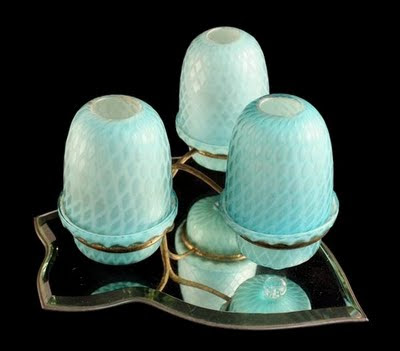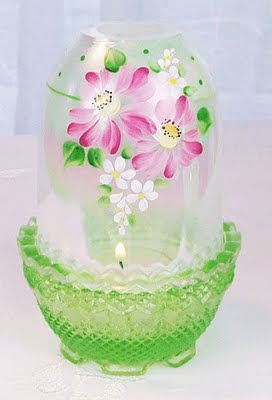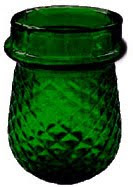
The After Glow of the Fairy Lamp

Can you imagine your home without our modern lighting?
Originally candles of all types were used to light homes.
Even today, when a storm takes out our electricity, most of us still revert to using candles.

Many changes occured through the years to improve the effectiveness of the light illuminated.
Finally in 1840 a new type of small, fat candle was developed.
These candles were encased with paper and set in a saucer of water to burn for any hours.
(It was also speculated that the water helped reduce the danger of fire,
a common tragedy of the Victorian era.)

Samuel Clarke was one of several designers in England working on lighting devices.
His patent, dated December 14, 1885, appears to be the basis of all fairy lamps.
The patent describes a glass cup covered witha dome.
In his patent he states that his improvements allow the light of the candle to be reflected through the dome and allows light to pass through the melted material.
It is not known for sure why Clarke decided to use a fairy as his trademark.
We can only assume that the light reminded him of a a fairy twinkling in the darkness.
His original candle cups have a fairy embossed on the bottom.
Clarke's fairy lamps became so popular that all small candle lamps today are simply referred to as "fairy lights".

Fairy lamps were extremely popular during the 1880s and '90s.
and continued to be popular inot the early 1900s.
Popularity faded in the '20s. Fairy lamps continued to be made as decorative items.
All production ended in the 1940s.
(With the availability of electricity, usage of fairy lamps waned in the 1920s and by the 1940s,
production ceased.)
During the 1950s the Fenton Art Glass company revived the fairy lamp.
Since that time hundreds have been made in many shapes, colors and sizes.
They still make fairy lamps today.
Other glass companies have also made fairy lamps:
Westmoreland, Viking, Indiana, LG Wright, Mosser and LE Smith among them.

Now, one hundred years later,
Clarke's fairy lamps are still as popular as theywere back in the 1880s and '90s!
Glass collectors as well as fairy lamp and lighting specialists seek out examples in everything from satinized cranberry to peachblow glass.
-Debbie Coe

Fairy lamps :
Their original purpose was utilitiarian, so they were frequently sold in boxed sets, a dozen at a time.
The typical pieces included the base, a cup for the candle, and the chimney or shade.
Over the years, their designs became more complex and ornate, though overall, most remained small,
standing four to six inches tall.

Clarke's original lamps feature a fairy embossed into the bottom,
known as "fairy lamps."
They became extremely popular, due to the sudden affordability of mass-produced glass and candles,
and were frequently used to illuminate nurseries, sickrooms, and hallways.
Samuel Clarke even designed a fairy lamp in the shape of a crown in honor of Queen Victoria's Jubilee.
The Queen reportedly purchased 1,500 of these lamps "for her own use".
3,000 of which were donated by Samuel Clarke.

Extra info:
Fairy lamps also came on elaborate stands, pottery bases, wall plaques,
chandeliers or epergnes, often with nosegay type flower holders.
Samuel Clarke had them made by other great names of the day,
Royal Worcester, Doulton, Taylor Tunnicliffe, Thomas Webb & Sons and Stevens & Williams.
In the late 1890’s Clarke patented the "Cricklite" style of candle lamp with clearglass domes
(Silk shades were extra) to go with the ever changing Victorian tastes
and to compete with the more modern types of lighting (gas & electricity).
Cricklites were expensive but could be seen and used in dinner settings,
they provided ample lighting to enhance a formal or festive occasion.
Then in 1910 The Clarke Candle Company was sold to The Price Candle Company.
They are beautiful and unique pieces of art and are the essence of all things Victorian.
They are delicate and elegant pieces which are a reminder of our past.
http://fairylamps.co.uk

Click on text to take you to page
Love & light
Trace
oxo












1 comment:
This unique design for lamp draw my attention, I am really surprised about there unique beauty I love this so much. And I also know about more other victorian chandeliers, To know about more visit our site.
Post a Comment